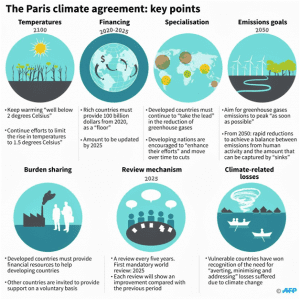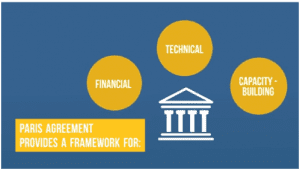Table of Contents
THE CONTEXT: December 12 marked the five-year anniversary of the Paris Agreement. The international community, including the European Union (EU) and India, gathered at the Climate Ambition Summit 2020 to celebrate and recognize our resolve in working towards a safer, more resilient world with net-zero emissions.
ABOUT PARIS AGREEMENT

- The Paris Agreement is a legally binding international treaty on climate change. It was adopted by 196 Parties at COP 21 in Paris, on 12 December 2015 and entered into force on 4 November 2016.
- Its goal is to limit global warming to well below 2, preferably to 5 degrees Celsius, compared to pre-industrial levels.
- To achieve this long-term temperature goal, countries aim to reach global peaking of greenhouse gas emissions as soon as possible to achieve a climate neutral world by mid-century.
- The Paris Agreement is a landmark in the multilateral climate change process because, for the first time, a binding agreement brings all nations into a common cause to undertake ambitious efforts to combat climate change and adapt to its effects.
IMPLEMENTATION OF PARIS AGREEMENT
Implementation of the Paris Agreement requires economic and social transformation, based on the best available science. The Paris Agreement works on a 5- year cycle of increasingly ambitious climate action carried out by countries. By 2020, countries submit their plans for climate action known as nationally determined contributions (NDCs).
Nationally Determined Contributions (NDCs)
In their NDCs, countries communicate actions they will take to reduce their Greenhouse Gas emissions in order to reach the goals of the Paris Agreement. Countries also communicate in the NDCs actions they will take to build resilience to adapt to the impacts of rising temperatures.
Long-Term Strategies
To better frame the efforts towards the long-term goal, the Paris Agreement invites countries to formulate and submit by 2020 long-term low greenhouse gas emission development strategies (LT-LEDS).
LT-LEDS provide the long-term horizon to the NDCs. Unlike NDCs, they are not mandatory. Nevertheless, they place the NDCs into the context of countries’ long-term planning and development priorities, providing a vision and direction for future development.
Is the Paris agreement binding?
The legal nature of the deal–whether it will be binding–had been a hotly debated topic in the lead up to the negotiations. The agreement walks a fine line, binding in some elements like reporting requirements, while leaving other aspects of the deal—such as the setting of emissions targets for any individual country—as non-binding.
Difference between Paris Climate and Kyoto Protocol
- The Kyoto Protocol had a differentiation between developed and developing countries listed as Annex 1 countries and non-Annex 1 countries But, in the Paris agreement, there is no difference between developing and developed countries.
- The Kyoto Protocol aimed at 6 major greenhouse gases but the Paris Agreement is focused on reducing all anthropogenic greenhouse gases causing climate change.
Talanoa dialogue
- The UNFCCC Climate Change Conference (COP23) was held in Bonn, Germany and was presided over by Government of Fiji. It concluded with countries putting in place a roadmap for ‘Talanoa Dialogue’, a year-long process to assess countries’ progress on climate actions.
What is Talanoa?
- Talanoa is a traditional approach used in Fiji and the Pacific to engage in an inclusive, participatory and transparent dialogue;
- The purpose of Talanoa is to share stories, build empathy and trust;
- During the process, participants advance their knowledge through common understanding;
- It creates a platform of dialogue, which results in better decision-making for the collective good;
- By focusing on the benefits of collective action, this process will inform decision-making and move the global climate agenda forward.
The significance of Talanoa dialogue
- The goal of the Paris Agreement on climate change, as agreed at the Conference of the Parties in 2015, is to keep global temperature rise this century to well below 2 degrees Celsius above pre-industrial levels. It also calls for efforts to limit the temperature increase even further to 1.5 degrees Celsius.
The Under2 Coalition
- The Under2 Coalition is a coalition of subnational governments that aims to achieve greenhouse gases emissions mitigation. It started as a memorandum of understanding, which was signed by twelve founding jurisdictions on May 19, 2015 in Sacramento, California. Although it was originally called the Under2 MOU, it became known as the Under2 Coalition in 2017.
- As of September 2018, the list of signatories has grown to over 220 jurisdictions which combined encompasses over 1.3 billion people and 43% of the world economy.
- The intent of the memorandum signatories is for each to achieve Greenhouse gas emission reductions consistent with a trajectory of 80 to 95 percent below 1990 levels by 2050and/or achieving a per capita annual emission goal of less than 2 metric tons by 2050.
- Currently, Telangana and Chhattisgarh are signatories to this pact from India, as compared to representations from the other top emitters: 26 subnational governments in China and 24 in the U.S. Greater representation of Indian States is crucial.
FRAMEWORK OF PARIS AGREEMENT
The Paris Agreement provides a framework for financial, technical and capacity building support to those countries who need it.

Finance
The Paris Agreement reaffirms that developed countries should take the lead in providing financial assistance to countries that are less endowed and more vulnerable, while for the first time also encouraging voluntary contributions by other Parties. Climate finance is needed for mitigation, because large-scale investments are required to significantly reduce emissions. Climate finance is equally important for adaptation, as significant financial resources are needed to adapt to the adverse effects and reduce the impacts of a changing climate.
Technology
The Paris Agreement speaks of the vision of fully realizing technology development and transfer for both improving resilience to climate change and reducing GHG emissions. It establishes a technology framework to provide overarching guidance to the well-functioning Technology Mechanism. The mechanism is accelerating technology development and transfer through it’s policy and implementation arms.
Capacity-Building
Not all developing countries have sufficient capacities to deal with many of the challenges brought by climate change. As a result, the Paris Agreement places great emphasis on climate-related capacity-building for developing countries and requests all developed countries to enhance support for capacity-building actions in developing countries.
ENHANCED TRANSPARENCY FRAMEWORK (ETF)
With the Paris Agreement, countries established an enhanced transparency framework (ETF). Under ETF, starting in 2024, countries will report transparently on actions taken and progress in climate change mitigation, adaptation measures and support provided or received. It also provides for international procedures for the review of the submitted reports.
The information gathered through the ETF will feed into the Global stocktake which will assess the collective progress towards the long-term climate goals.
This will lead to recommendations for countries to set more ambitious plans in the next round.
INDIA AND PARIS AGREEMENT
India has not only achieved its targets but has exceeded them beyond expectations as per the Prime Minister. He delivered a virtual speech at the Climate Ambition Summit that India has reduced its global emissions by 21 percent compared to 2005 and is on its way to do more.
- India mentioned that it has not caused the climate change crisis and it is meeting its obligations under the Paris Climate Accord.
- It stated that the developed nations have been the highest carbon emitters and thus, were responsible for global warming.
- It mentioned that besides India, only Bhutan, the Philippines, Costa Rica, Ethiopia, Morocco and Gambia were complying with the accord.
India’s Intended Nationally Determined Contribution (INDC)
- To reduce the emissions intensity of its GDP by 33 to 35 percent by 2030 from 2005 level.
- To create an additional carbon sink of 2.5 to 3 billion tonnes of CO2 equivalent through additional forest and tree cover by 2030.
- A total of 40% of the installed capacity for electricity will be from non-fossil fuel sources.
India’s effort to address Climate Change
The Government of India has launched eight Missions under the National Action Plan on Climate Change (NAPCC) for assessment of the impact and actions required to address climate change. These eight missions are:
- National Solar Mission
- National Mission for Enhanced Energy Efficiency
- National Mission on Sustainable Habitat
- National Water Mission
- National Mission for Sustaining the Himalayan Ecosystem
- National Mission for A Green India
- National Mission for Sustainable Agriculture
- National Mission on Strategic Knowledge for Climate Change
Recent developments
- India has achieved a reduction of 21% in emission intensity of its GDP between 2005 and 2014, which fulfills its pre-2020 voluntary target.
- The Renewable energy installed capacity has increased by 226% in the last 5 years and stands more than 87 GW.
- The Government has provided 80 million LPG connections in rural areas, providing them with clean cooking fuel and a healthy environment.
- More than 360 million LED bulbs have been distributed under the UJALA scheme, which has led to energy saving of about 47 billion units of electricity per year and reduction of 38 million tonnes of CO2 per year.
- It leapfrogged from Bharat Stage-IV (BS-IV) to Bharat Stage-VI (BS-VI) emission norms by April 1, 2020 which was earlier to be adopted by 2024.
FIVE YEARS AFTER PARIS AGREEMENT
All states have submitted their national contributions to mitigate and adapt to climate change. Distant hypothetical targets are being set. Seems like we are still speeding in the wrong direction or we are lagging far behind.
(1) Unclear targets and response
The world is still unclear since five years as to how the net-zero pledges will translate into shorter term targets. Few of the countries that have announced ambitious long-term goals have implemented national policies to reach them in time.
(2) Degradation isn’t stopped
Meanwhile, we continue to destroy the world’s carbon sinks, by cutting down forests – the world is still losing an area of forest the size of the UK each year, despite commitments to stop deforestation – as well as drying out peatlands and wetlands, and reducing the ocean’s capacity to absorb carbon from the air.
(3) Countries aren’t scaling up their targets
Although 151 states have indicated that they will submit stronger targets before December 31, only 13 of them, covering 2.4 per cent of global emissions, have submitted such targets. While states have been slow to update their national contributions for 2025-2030, several have announced exaggeratedly high “net zero” targets in the recent past.
WAY FORWARD:
- The Paris agreement still provides the best hope of avoiding the worst ravages of climate breakdown: the question is whether countries are prepared to back it up with action, rather than more hot air.
- Renewing the shorter term commitments is the best way ahead.
- Making promises for the 2050s-60s is one thing, but major policy changes are needed now to shift national economies on to a low-carbon footing.
- None of these (net zero) targets will be meaningful without very aggressive action in this decade. Diplomacy is inevitably a tool in global climate action.
CONCLUSION:
For many, there is a mismatch between short-term actions and long-term commitments. A credible short-term commitment with a clear pathway is the key. Not all states will be in a position to pledge net-zero targets, nor should they be expected to. All states, including India, can, however, pledge actions that are credible, accountable and fair. Our real test on climate change is on building a new domestic consensus that can address the economic and political costs associated with an internal adjustment to the prospect of a great global reset.
Spread the Word
